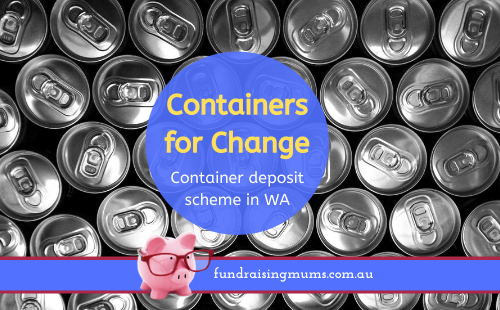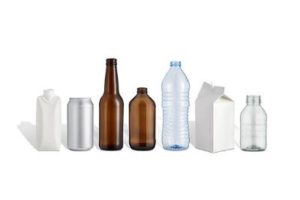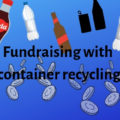
It’s been a long time coming but Western Australia’s container deposit scheme will be launched on October 1st, 2020, providing WA schools, sporting clubs, charities and community groups a great new way to raise funds. Run by Containers for Change, the program provides a refund of 10 cents for each eligible container that is returned to a Refund Point.
The program is designed to reduce both landfill and litter and increase interest in sustainable practices and recycling. It also gives schools and charities a great opportunity to fundraise.
Who can use the Containers for Change scheme to earn cash?
Anyone from individuals to schools and charities can use the scheme to raise funds. Only certain groups can apply for a Scheme ID, which will allow people to direct their funds to you, but anyone can return containers to a refund point and collect the money.
How much money can my school make?
All eligible containers are valued at 10-cents each. If the average family uses 5 containers a week and donates them once a month to their school or club, a school with 200 families would collect $400 a month or $4,800 a year.
If students are actively searching for eligible litter or calling on the local community to donate their containers or refunds, this could be significantly more.

What type of containers can be exchanged?
Most containers made from glass, plastic, steel, aluminium and liquid paperboard between 150ml and 3L will be eligible for a refund. This includes things like beer bottles, plastic water bottles, soda cans, juice boxes and flavoured milk cartons.
Containers which are not included in the scheme are plain milk and cordial containers, bottles containing wine or pure spirits, containers over 1 litre that had pure fruit/vegetable juice or flavoured milk. These items can still be recycled through the normal yellow kerbside recycling bins.
The scheme is limited primarily those containers which are most commonly discarded as litter.
You can find the list of eligible and ineligible containers here.
The containers must have the refund mark. Many will already have them as container schemes have been operating in South Australia and the Northern Territory for years, however, local producers have two years to display the mark on their products.
The containers must be empty and the lids must be removed.
How to start a container deposit fundraiser for your school or community group
The first step is to sign up for a Scheme ID by visiting the site here. This allows your community and supporters to direct their refunds to you.
Next, you need to decide if you are going to be a physical or virtual collection point – or both.
A physical collection point means you will need to designate a space in your school or community for a large cage or bins where people can deposit their containers. This might be available permanently to your community for them to drop off as they wish, alternatively, you might have designated drop-off days.
Being a physical donation point is more work: it requires space to store the containers as well as volunteers to take them to a refund point. However, you are probably more likely to get greater funds because you are taking on the most inconvenient aspect of the scheme on behalf of your community.
To be a virtual collection point means people donate their refund to your charity/school when they drop their containers off at one of the collection points. To do this, simply provide your charity ID to your community and ask that any refund be credited to your community group.
It’s worth keeping in mind, that since they are doing the hard work, some people may choose to keep the funds themselves.
Where are the refund collection points?
There will be four ways to obtain a refund.
- Reverse Vending Machines where you scan the barcode of the eligible container and the machine keeps the container. Please note that most RVMs do not pay out cash but typically offer a voucher system for a local retailer such as a supermarket. Alternatively, people can forgo their refund and direct it to a registered charity or community group.
- Over the counter depots will accept containers and refund immediately either in cash or electronic funds transfer (or the refund can be directed to a group with a scheme ID).
- Drop off locations allow you to leave eligible containers (bagged appropriately and tagged with your ID) and you don’t need to wait for them to be counted.
- Mobile drop-off points that will operate from special events and functions.
There will a minimum of 172 refund points when the scheme starts and 229 by the end of the first year, including in remote and rural WA. Check the website for locations of Refund Points near you.
If you are registering your group as a physical collection point, you will need to identify your nearest over the counter depot or drop off location to cope with the quality of containers you will collect. Having access to a caged trailer will also make life easier, rather than transporting (probably wet) containers in the back of a car.
How to boost your fundraising options
As with all passive fundraising options, reminding your community constantly is essential for its success. Don’t limit yourself to your members but promote your physical drop off point (or Scheme ID for virtual donations) to the wider community so they can help as well.
Approach local farmers’ markets and large sporting events to see if you can bring along a caged trailer to their events. Many events sell lots of bottled water and soft drink cans that you can take advantage of. Leave signs next to point-of-sale and rubbish bins with maps directing them to your collection point.
Other ideas for physically collecting containers include a sporting club hiring a large cage trailer once a month for players to drop off their containers, a school fete asking visitors to donate ten eligible containers to gain entry to the event or a donation of five containers for students to participate in a Free Dress Day. You could even approach your local Bunnings to see if you could collect empty cans and bottles from their fundraising sausage sizzles.
For container recycling in New South Wales, Queensland and the Northern Territory, read my article here.



